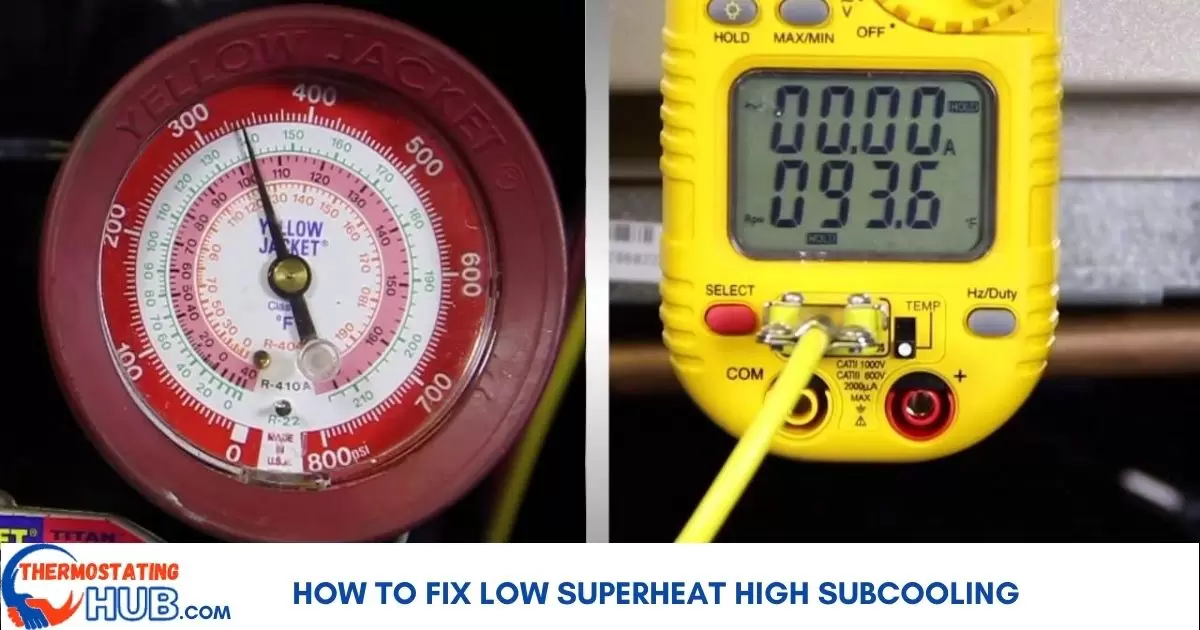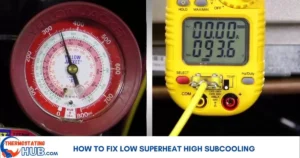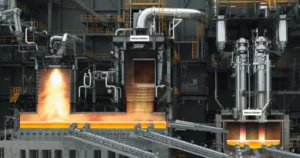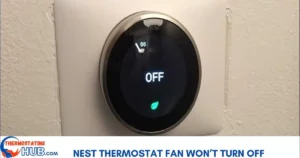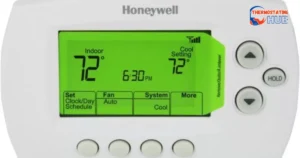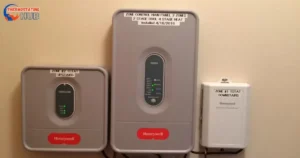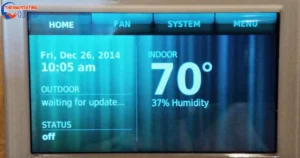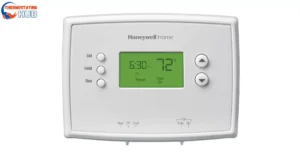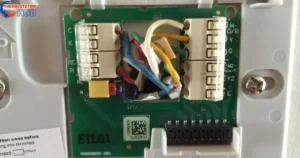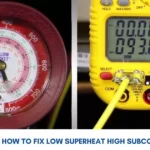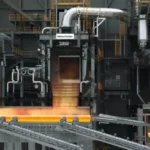When dealing with air conditioning issues, understanding low superheat and high subcooling is crucial. Low superheat and high subcooling often point to a common problem: too much refrigerant in the air conditioning system. To fix this, simply remove the excess refrigerant from the system.
Now, let’s delve into the specifics. Low superheat occurs when there’s not enough heat added to the refrigerant, and high subcooling happens when the refrigerant is cooler than it should be before entering the evaporator.
Both issues are often the result of an excessive refrigerant charge. To resolve this, it’s essential to discharge the extra refrigerant from the air conditioning system.
Understanding and addressing these factors ensures your air conditioning system functions optimally.
What causes low superheat?
Superheat acts as a gauge for the amount of refrigerant present in the evaporator coils. When superheat is low, it signals that either there’s not sufficient heat in the evaporator coil or an excess amount of refrigerant is present.
Several issues can lead to low superheat, such as:
- Overcharged AC System: Too much refrigerant in the system can result in low superheat.
- Restricted Airflow to the Evaporator Coil: This can occur due to dirty air filters, hindering the heat exchange process.
- Overfeeding of the Metering Device: When the metering device delivers more refrigerant than needed, it can cause low superheat.
- Oversized AC System: If the air conditioning system is larger than necessary, it may contribute to low superheat.
Addressing these issues promptly ensures the proper functioning of the air conditioning system and optimal superheat levels. ⚙️
| Possible Cause | Main Fix |
| Excessive refrigerant in the AC system | Discharge some refrigerant |
| Restricted airflow to the evaporator | Replace air filters and the blower wheel |
| Overfeeding of the metering device | Ensure sensing valve of the TXV is properly insulated |
| Insufficient heat load to the coil | Clean the filters and the coil |
| Oversized AC system | Consider going for a well-sized AC unit |
1) Excessive refrigerant in the AC system
When an excess of refrigerant reaches the evaporator coil, more liquid refrigerant enters the system. This influx of liquid reduces the amount of heat absorbed. Typically, heat is absorbed through the refrigerant’s evaporation process.
In cases where there’s insufficient evaporation due to an excess of liquid refrigerant, it results in what’s known as low superheat. This condition poses a risk, as more liquid refrigerant might find its way into the compressor, potentially causing damage. The compressor is specifically designed to compress gaseous refrigerant, not liquid.
The root of excessive refrigerant in the system can often be traced back to a malfunctioning or stuck open TXV valve. To remedy this, discharging some refrigerant from the AC system to achieve the correct levels is the recommended solution.
2) Restricted air flow to the evaporator
Insufficient airflow to the evaporator coil can lead to a decrease in heat absorption, potentially causing low superheat. Several factors may restrict air to the evaporator coil, including:
Dirty Evaporator Coil: The accumulation of dirt or buildup on the coils significantly reduces their open surface area. This reduction limits the amount of air coming into contact with the coil, hindering heat absorption.
Dirty Air Filter: When air filters are dirty or clogged, they impede the airflow to the evaporator coil. Since air passes through the filter before reaching the coils, a clogged filter reduces the space available for air to pass. This restriction leads to minimal air reaching the coil, resulting in limited heat absorption by the evaporator.
Regular maintenance, such as cleaning coils and replacing air filters, ensures proper airflow and helps prevent issues like low superheat.
Solution
To tackle both scenarios effectively, it’s crucial to maintain a clean evaporator coil and regularly replace or clean the air filter. When filters go beyond their scheduled replacements or cleaning, it often results in the coils accumulating dirt over time. By proactively cleaning the coils and ensuring timely air filter replacements, the issue of low superheat can be successfully resolved. This routine upkeep promotes optimal performance and extends the life of your air conditioning system. ✨
3) Overfeeding of the metering device
If the metering device lacks proper insulation, it can permit an excess of refrigerant to reach the evaporator coil, leading to a potential issue known as flooding. To prevent overfeeding of the metering device, it is essential to ensure that it is adequately insulated.
Proper insulation acts as a safeguard, maintaining the correct flow of refrigerant and preventing flooding in the evaporator coil. Regular checks and insulation maintenance contribute to the efficient operation of the air conditioning system.
4) Oversized AC system
An oversized AC system poses a challenge because there isn’t enough heat load to vaporize the refrigerant in the evaporator coils. The excess capacity of the system can lead to low superheat, as there’s insufficient heat to initiate the necessary vaporization process in the coils.
Right-sizing the AC system according to the specific heat load requirements ensures optimal performance, preventing issues like low superheat.
Solution
To remedy this issue, it’s crucial to ensure that the HVAC equipment used is of the correct size. Choosing the appropriate size ensures that the system aligns with the specific heating and cooling requirements, preventing complications like low superheat. Selecting the right-sized equipment promotes efficiency and maintains the proper functioning of the air conditioning system.
Read Also: Goodman Furnace 3 Flashes
How to determine whether you have Low or high superheat on an AC
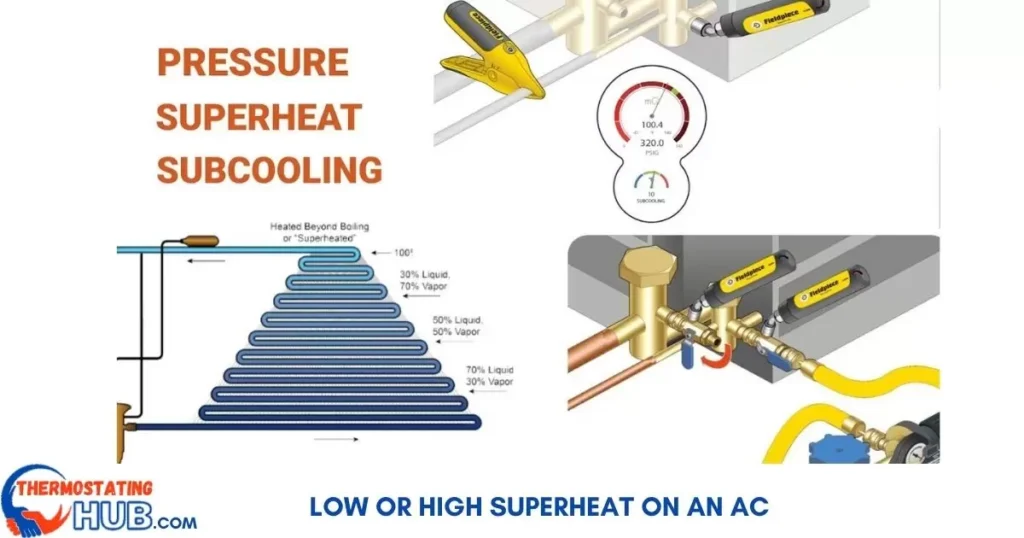
You can easily check superheat by following a simple method. If there’s an insufficient heat load on the evaporator, it results in low superheat. Conversely, inadequate refrigerant reaching the evaporator leads to high superheat.
For this check, you’ll need:
1. A thermometer designed for pip temperature measurement.
2. A temperature/pressure chart to convert the temperature readings to pressure.
By utilizing these tools, you can assess and manage superheat levels, ensuring your air conditioning system operates effectively.
Procedure
To check superheat effectively:
1. Use a thermometer to measure the temperature on the suction line.
2. Convert this temperature to pressure (psi) using the temperature/pressure chart.
3. Measure the pressure at the suction line and convert it to temperature using the same chart.
4. Find the difference between the two temperatures.
Normal superheat for any system is typically about 10°F when measured at the evaporator and approximately 20°F to 25°F when measured near the compressor.
Low superheat occurs if the temperature difference at the evaporator is less than 10°F and near the compressor is less than 20°F.
Conversely, high superheat is indicated if the temperature readings are greater than 10°F at the evaporator and greater than 10°F near the compressor.
This simple method helps in assessing superheat levels, ensuring your system operates within the recommended temperature ranges.
Example
In the given example, with a pressure of 65 psi on the suction line in an R-22 system, consulting the temperature pressure chart reveals a corresponding temperature of 38°F. If the actual temperature measured on the suction line is 68°F, the difference between the two temperatures is calculated as 30°F.
Since 30°F exceeds the normal range of 10°F, this indicates a high superheat. If the temperature difference had been less than 10°F, it would have indicated low superheat.
This analysis helps in identifying and understanding the superheat levels in the system, allowing for appropriate adjustments if necessary.
What causes high subcool
Subcooling serves as an indicator of the refrigerant accumulating in the condenser unit. When subcooling is high, it means there’s an excess of refrigerant backing up in the condenser.
Several issues can lead to high subcooling, including:
- Overcharged AC System: Too much refrigerant in the system can result in high subcooling.
- Undersized or Failing Closed Metering Device: A metering device that is either too small or not functioning properly can contribute to high subcooling.
- Restriction of the Liquid Line: Issues such as a kinked line can impede the flow of liquid and lead to high subcooling.
Here’s a quick reference table for the causes and fixes of high subcooling:
| Possible Cause | Main Fix |
| Overcharged AC system | Discharge some refrigerant |
| Faulty Metering Device | Use a properly sized metering device |
| Restriction of the Liquid Line | Ensure lines are not restricted; straighten kinked lines |
Addressing these issues promptly ensures the proper functioning of the air conditioning system and maintains optimal subcooling levels.
1) Overcharging the system will cause high subcool
When there’s too much refrigerant in the system, the normal processes of condensation and evaporation get disrupted. Instead of these processes occurring as they should, the excess refrigerant backs up in the condenser unit.
This backup can lead to inefficiencies and issues within the air conditioning system. Maintaining the correct refrigerant levels is crucial for ensuring that condensation and evaporation proceed as intended, optimizing the overall performance of the system.
2) Faulty metering device
Issues with the metering device can indeed contribute to high subcooling. This encompasses situations where the metering device is underfeeding, undersized, or when there’s a fault in the head pressure control system.
A properly functioning metering device is essential for regulating the flow of refrigerant and maintaining optimal conditions within the air conditioning system. Identifying and addressing problems with the metering device is crucial to preventing issues like high subcooling and ensuring efficient system operation.
3) Restriction of the liquid line
A restriction in the liquid line can also be a culprit for high subcooling. When there’s a blockage or restriction in the liquid line, the flow of refrigerant is impeded, causing excess refrigerant to accumulate in the condenser unit.
To address this issue, it’s important to ensure that the liquid lines are free from any restrictions, such as kinks or blockages. Keeping the liquid lines clear and unobstructed is key to maintaining proper refrigerant flow and preventing high subcooling.
Solution
To resolve the issue of high subcooling, discharging excess refrigerant to standard levels is an effective solution. However, it’s crucial to verify that refrigerant is genuinely in excess before taking this step. Sometimes, a combination of high subcooling and high superheat can be attributed to a defective or malfunctioning metering device.
Checking and ensuring the proper functionality of the metering device is essential before making adjustments to the refrigerant levels. This ensures accurate diagnosis and targeted solutions for optimal system performance.
What causes Low superheat with high subcool
When both low superheat and high subcooling occur simultaneously, it signals a unique condition that can only be attributed to an overall excess of refrigerant in the system. Overcharging the air conditioning system with refrigerant is the primary cause of experiencing both low superheat and high subcooling concurrently.
It’s important to avoid overcharging, as it disrupts the balance in the system, leading to these dual issues. Maintaining the correct refrigerant levels is essential for ensuring the proper functioning of the air conditioning system.
How to determine if you have a low or high subcool
To check subcooling, follow these steps:
- Measure the temperature at the liquid line near the condenser.
- Take the head pressure and convert it to temperature using the pressure-temperature chart.
By comparing the temperature at the liquid line with the converted temperature from the head pressure, you can determine the subcooling. This process helps in assessing whether the refrigerant is within the appropriate range and ensures the efficient operation of the air conditioning system.
Example
In the provided example, with a head pressure reading of 260 psi converted to a temperature of 120°F and a liquid line temperature recorded at 85°F, the subcooling is calculated at 35°F.
This indicates high subcooling, as the normal range for systems utilizing a thermostatic expansion valve (TXV) is typically between 10°F and 18°F. A subcooling measurement lower than this range would be considered low subcooling.
Monitoring and interpreting subcooling values are essential for ensuring that the refrigerant is within the appropriate range and optimizing the efficiency of the air conditioning system.
Key Takeaways for Effectively Fixing Low Superheat and High Subcooling Problems
Sure, let’s break down the key takeaways for effectively fixing low superheat and high subcooling problems:
Low Superheat
- Check Refrigerant Charge: Ensure that the refrigerant level is appropriate. Inadequate refrigerant in the system may be the cause of low superheat.
- Inspect the Evaporator Coil: Examine the evaporator coil for dirt or debris. A dirty coil can lead to reduced heat absorption and low superheat.
- Evaluate Expansion Valve: assess the expansion valve for proper functioning. Malfunctioning valves can impact superheat levels.
- Temperature Sensors: Verify the accuracy of temperature sensors. Faulty sensors may provide incorrect readings, affecting the superheat.
- Adjust Refrigerant Flow: Fine-tune the refrigerant flow rate. Incorrect flow can result in low superheat.
High Subcooling
- Check Condenser Coil: Inspect the condenser coil for dirt or blockages. A dirty coil can hinder heat dissipation, leading to high subcooling.
- Evaluate Condenser Fan: Ensure the condenser fan is working properly. Inadequate airflow can cause subcooling to rise.
- Check Refrigerant Charge: Verify that the refrigerant charge is within the recommended range. Overcharging can contribute to high subcooling.
- Examine Expansion Valve: Assess the expansion valve for proper operation. A malfunctioning valve can impact subcooling levels.
- Temperature Sensors: Confirm the accuracy of temperature sensors. Faulty sensors may provide incorrect readings, affecting subcooling.
Remember, these takeaways are general guidelines. For specific instructions related to your system, always refer to the manufacturer’s guidelines and consider seeking professional assistance if needed.
Pros and Cons of Addressing Low Superheat and High Subcooling Issues
Let’s present the pros and cons of addressing low superheat and high subcooling issues in a table format:
| Pros | Cons |
| 1. Efficient Cooling: Resolving low superheat ensures optimal heat absorption, improving cooling efficiency. | 1. Technical Expertise: Fixing refrigerant issues may require specialized knowledge. |
| 2. System Longevity: Proper superheat levels contribute to the longevity of the compressor and other components. | 2. Time-consuming: Diagnosing and fixing these issues can be time-intensive. |
| 3. Energy Savings: Correcting superheat and subcooling problems can enhance energy efficiency, leading to cost savings. | 3. Cost: Depending on the issue, repairs or adjustments may incur additional costs. |
| 4. Consistent Performance: Maintaining recommended levels ensures consistent system performance. | 4. Risk of Incorrect Fix: DIY attempts may lead to misdiagnosis and worsen the problem. |
| 5. Comfort Improvement: Fixes contribute to maintaining comfortable indoor temperatures. | 5. Need for Tools: Some solutions may require specific tools or equipment. |
Remember, the decision to address these issues should be based on your comfort level with troubleshooting HVAC systems. If uncertain, seeking professional assistance is always a good option to avoid potential complications.
Exploring Future Innovations in Resolving Low Superheat and High Subcooling Challenges
Let’s dive into the potential future innovations for resolving low superheat and high subcooling challenges:
1. Advanced Sensors and Smart Systems:
Prospective innovation could involve the development of more sophisticated sensors and smart systems. These systems may offer real-time monitoring of superheat and subcooling levels, allowing for immediate adjustments and preventive measures.
2. Artificial Intelligence (AI) Integration:
AI algorithms could be integrated into HVAC systems to analyze complex data patterns. This could enable predictive maintenance, automatically detecting and resolving issues related to low superheat or high subcooling before they become significant problems.
3. Internet of Things (IoT) Connectivity:
Future innovations might focus on enhanced connectivity. IoT integration could facilitate remote monitoring and control, allowing HVAC professionals to address low superheat and high subcooling challenges from anywhere.
4. Self-Adjusting Refrigerant Systems:
Developments in refrigerant technology may lead to self-adjusting systems. These systems could automatically regulate refrigerant levels based on real-time conditions, minimizing the need for manual adjustments.
5. Augmented Reality (AR) for Troubleshooting:
Innovations in AR could provide HVAC technicians with virtual assistance for diagnosing and fixing issues. Technicians could wear AR glasses, receiving step-by-step guidance for resolving low superheat and high subcooling challenges.
6. Green Refrigerants and Sustainable Solutions:
Future innovations may prioritize environmentally friendly refrigerants that contribute to efficient HVAC operation. This could involve the development of sustainable solutions that minimize the impact on the environment.
7. Enhanced Training and Education Tools:
Innovations may focus on creating advanced training and education tools for HVAC professionals. This could include virtual reality (VR) simulations and interactive learning platforms to improve troubleshooting skills.
Remember, these are speculative ideas, and actual innovations may vary. Keeping an eye on industry trends and advancements can help anticipate and adopt new technologies as they emerge.
FAQs
What causes low superheat and high subcool?
Insufficient refrigerant in the evaporator coil may lead to low superheat, whereas an overabundance of refrigerant in the condenser may cause high subcooling. Both issues may be related to problems such as improper refrigerant charge, issues with the expansion valve, or restrictions in the refrigerant flow.
How do you bring superheat down?
To lower the superheat, you may need to adjust the refrigerant charge. This involves adding or removing refrigerant based on manufacturer specifications. Properly calibrate the expansion valve and ensure the evaporator coil receives the right amount of refrigerant. Monitoring and adjusting these factors can help bring superheat to the desired level.
What happens if subcooling is high?
High subcooling indicates an excessive amount of liquid refrigerant in the condenser. This can lead to inefficient cooling, increased compressor workload, and potential damage to the system. It’s essential to investigate and address the root cause, which could include issues with the condenser, expansion valve, or refrigerant overcharge.
How do you raise superheat?
To increase superheat, you might need to adjust the refrigerant charge by removing some refrigerant according to manufacturer guidelines. Additionally, adjusting the expansion valve to allow less refrigerant into the evaporator can help raise superheat. It’s crucial to follow proper procedures and consult the system’s specifications for optimal adjustments.
Final thoughts
Now that we’ve explored the causes of low superheat and high subcooling, we trust that you’ve successfully addressed any issues within your system. We appreciate your ongoing support in reading our guides.
Should you have any further questions or concerns, feel free to reach out via email. We’re here to assist you. Thank you for choosing our resources, and we look forward to supporting you in the future.

I’m Justin Taylor, your HVAC aficionado at thermostatinghub.com. I’m not just a writer; I’m your problem-solving partner for all things thermostat-related. Join me on my blog for stories that unravel the mysteries of heating and cooling. Let’s turn your HVAC puzzles into tales of comfort and control!
